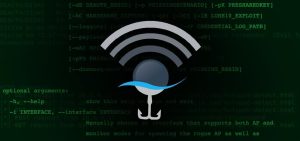Wifiphisher – Extra Phishing Scenario: Enhancing Phishing Method for Advanced Attacks
Introduction
Welcome to this comprehensive guide on Wifiphisher – Extra Phishing Scenario, where we will explore the advanced techniques and scenarios involved in enhancing phishing attacks using Wifiphisher. Phishing has become one of the most prevalent cyber threats, targeting individuals and organizations alike. With the rapid evolution of technology, attackers constantly seek new ways to deceive unsuspecting users. Wifiphisher provides an innovative approach to phishing by exploiting vulnerabilities in Wi-Fi networks, making it a powerful tool in the hands of attackers. In this article, we will delve into the intricacies of this extra phishing scenario and discuss how it can be employed to conduct more sophisticated and successful phishing campaigns.
Wifiphisher – Extra Phishing Scenario: A Deeper Dive
Wifiphisher is an open-source Python tool that leverages the power of social engineering to perform wireless phishing attacks. By exploiting vulnerabilities in Wi-Fi networks, Wifiphisher tricks users into unknowingly connecting to a rogue access point (AP) masquerading as a legitimate network. Once connected, the attacker gains unauthorized access to the victim’s sensitive information, such as login credentials, personal data, or financial details. The extra phishing scenario takes this technique to the next level, enabling attackers to manipulate user behavior and maximize the success rate of their phishing campaigns.
Wifiphisher works on Kali Linux and is licensed under the GPL license.

Listed below are some extra phishing scenarios for wifiphisher these scenarios are only added to provide security awareness. It may not be legal in your country to use these scripts please read disclaimer before attempting to download any content from this page.
Be responsible with these scenarios !. They are intended to be tested on your own network, and only your own network or networks & clients you have permission to test these phishing scenarios on.
Amazon


Yahoo


Starbucks

SnapChat

McDonald’s

GoPro

# Creating a custom phishing scenario
———————————–
For specific target-oriented attacks, custom scenarios may be necessary.
Creating a phishing scenario is easy and consists of two steps:
1) Create the config.ini
A config.ini file lies in the template’s root directory and also its contents can be divided into two sections:
i) info: This section defines the scenario’s characteristics.
– Name (mandatory): The name of the phishing scenario
– Description (mandatory): A quick description (<50 words) of the scenario
– PayloadPath (optional): If the phishing scenario pushes malware to victims, users can insert the absolute path of the malicious executable here
ii) context: This section is optional and holds user-defined variables that may be later injected to the template.
#### Example
Here`s an example of a config.ini file:
# This is a comment
[info] Name: ISP warning page
Description: A warning page from the victim`s ISP asking for DSL credentials
[context] victim_name: John Phisher
victim_ISP: Interwebz
2) Create the template files
A template contains the static parts of the desired HTML output and may consist of several static HTML files, images, CSS or Javascript files. Dynamic languages (e.g. PHP) are not supported.
### Placeholders
The HTML files may also contain some special syntax (think placeholders) describing how dynamic content will be inserted. The dynamic contect may originate from two sources:
i) Beacon frames. also Beacon frames contain all the information about the target network and can be used for information gathering. The main process gathers all the interesting information and passes them to the chosen template on the runtime.
At the time of writing, the main process passes the following data:
“`target_ap_essid“` : The ESSID of the target Access Point<br/>
“`target_ap_bssid“` : The BSSID (MAC) address of the target Access Point<br/>
“`target_ap_channel“` : The channel of the target Access Point<br/>
“`target_ap_vendor“` : The vendor’s name of the target Access Point<br/>
“`target_ap_logo_path“` : The relative path of the target Access Point vendor’s logo in the filesystem<br/>
“`APs“` : A list containing AP dictionaries of the Access Points captured during the<br/>
“`AP“` : A dictionary holding the following information regarding an Access Point:<br/>
“`channel“` : The channel of the Access Point<br/>
essid“` :The ESSID of the Access Point<br/>
“`bssid“` :The BSSID (MAC) address of the Access Point<br/>
“`vendor“` :The vendor’s name of the Access Point<br/>
Note that the above values may be ‘None’ accordingly. For example, all the target_* values will be None if their user did not target an Access Point (by using –essid option). then The ‘target_ap_logo_path’ will be None if the logo of the specific vendor does not exist in the repository.
ii) The config.ini file (described above). also, All the variables defined in the “Context” section may be used from within the template files.
In case of naming conflicts, the variables from the configuration file will override those coming from the beacon frames.
### Logging credentials
In order for wifiphisher to know which credentials to log, the values of the ‘name’ HTML attributes need to be prefix with the ‘wfphshr’ string. During POST requests, wifiphisher will log all variables that are prefixed with this string.
#### Example
<b>Here’s a snippet from a template (index.html):</b>
<p> Dear {{ victim_name }}, This is a message from {{ ISP }}.</p>
<p>A problem was detected regarding your {{ target_ap_vendor }} router. </p>
<p> Please write your credentials to re-connect over PPPOE/PPPOA.</p>
<input type=”text” name=”wphshr-username”></input>
<input type=”text” name=”wphshr-password”></input>
“`
In this example, <b>’victim_name'</b> and <b>’ISP'</b> variables come from config.ini, while <b>’target_ap_vendor'</b> variable is from the beacon frames. Both “wphshr-username” and “wphshr-password” will be logged.
You can also buy instant:


Cashapp Money Transfer Click here
Paypal Money Transfer Click here
Western Union Money Transfer Click here
Venmo Money Transfer Click here
Bank Money Transfer Click here to Contact Us
